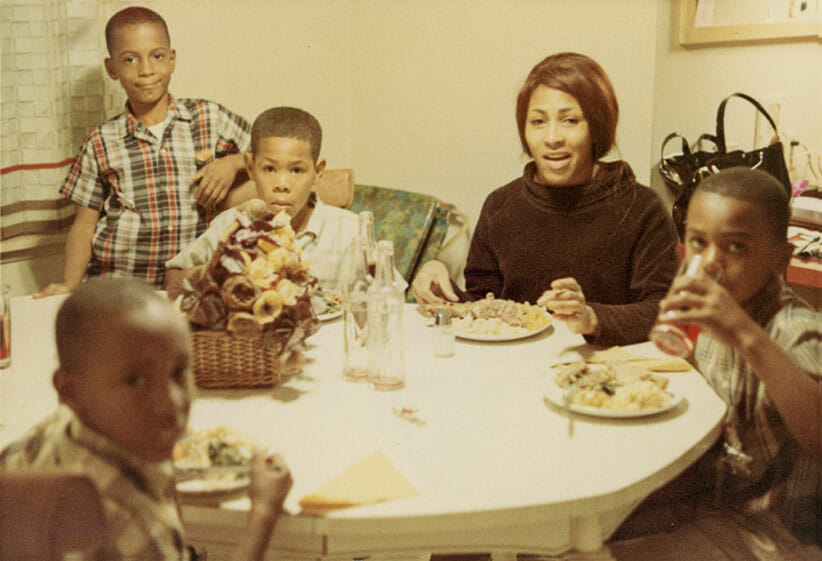Tina Turner is an legend, an entertainer, a survivor….and a woman who has practiced the art of chanting for transformation.
At 81, the icon reflects, “Each of us is born, I believe, with a unique mission, a purpose in life that only we can fulfill. We are linked by a shared responsibility: to help our human family grow kinder and happier.” This is an outlook gleaned from the four decades of “Changing Poison into Medicine.” It is a Buddhist practice that many say Tina has mastered this lifetime.
Tina Turner was born Anna Mae Bullock in Nutbush, Tennessee, 1939. Her father was a sharecropper in the still racist and stifled south. A local civil rights leader was lynched not far from the home they inhabited on the Poindexter Families’ farm. The singer recalls, “I was the child my mother never wanted; that was a heavy burden for a little girl to bear.”
The Bullocks would abandon their daughters for years at a time. They awaited the phone call, the letter, the explanation that would never come. Tina recalls, “Fantasies about the silver screen often got me through difficult times. When I was working in the fields, picking cotton and strawberries in oppressive heat, I would imagine a far-off paradise where I could live like the elegant movie stars did. I had no idea where this magical ‘Hollywood’ was, but I knew, deep down inside, that I wasn’t destined to stay in the farmlands. Even then I did not believe that my circumstances would limit my possibilities. I knew that someday I’d find my way out into the world.”
When Anna Mae was 16, her grandmother died. Out of other options, the girls moved in with their reluctant mother, in St. Louis, Missouri. They snuck off to the Club Manhattan to see Ike Turner and the Kings of Rhythm Band. Tina remembers, “He picked up his guitar and hit one note and it was just like ‘Jesus listen to this guy play.’ I almost went into a trance when I saw him.”
Years prior , in 1951, Ike Turner wrote and recorded what many consider the first rock n’ roll record of all time; “Rocket 88.” However, when the album came out it was credited to his saxophone player (Jackie Brenston) – a plot point that would shape his every thought and action thereafter.
Anna Mae idolized Ike. Week after week asked if she could sit in for a song. One Sunday night, the Rhythm Kings drummer put a mic down on the club floor. The frail teen wailed B.B. King’s, “You Know I love You.” Hours later she was asked to join the band. The soulful singers’ stage presence was unparalleled. Ike wasn’t going to let anyone else’s success evade him, so unbeknownst to her, Ike legally changed Anna Mae’s name to Tina. They later wed in a civil ceremony.
Ike and Tina Turner’s debut album, “A Fool in Love,” topped the R&B Charts, and quickly crossed over to the Billboard Hot 100. They did grueling one-night gigs across the country, ascending to national television spots on the late night shows. They attracted the attention of mega-producer Phil Spector, who paid Ike to stay out of the studio while he recorded Tina’s vocals over a string section on the single, “River Deep, Mountain High.” It was a new sound that secured the couple as the opening act on The Rolling Stones Fall ’66 tour. It is even said she taught Stones frontman Mick Jagger how to dance.
Although all of Ike’s tightly-held dreams were coming true, the success inflamed his deepest insecurities. The bigger they became, the more he tried to control everything and everyone around him. He built a recording studio with automatic locks, and cameras in every room, had extramarital affairs with other women named Ann and indulged in a thousand dollar per week cocaine habit that burned a hole through his nose.

Tina Turner and her children (1967). Photograph courtesy of Rhonda Graam/HBO
Tina and her housekeeper were raising four children; two from Ike’s previous marriage, Ike Jr. and Michael; Craig from a prior relationship of Tina’s, and Ronnie, whom they shared. When she was pregnant with Ronnie, Ike brutalized the young mother. Tina remembers, “He beat me with a shoe stretcher, and after that he made me go to bed and he had sex with me, and I was all swollen and that was the beginning of the torture. That was the beginning of how it was.”
For seventeen years, Tina arrived at rehearsals and shows with black eyes and bruised lips, dislocated joints and broken bones. She was scalded with hot coffee, and had her jaw cracked. People in their inner and outer circles would extend the heavily subtexted, “Are you ok Tina..?” “Are you taking care of yourself..?” These are coded questions customary to victims of domestic violence. She made a futile escape attempt, but was found before she could even get on the bus. Despondent and unable to see another way out, the 29-year-old took 50 sleeping pills. The emergency room doctors pumped her stomach and tried to get a pulse. When Ike came in the room and shouted “M*therfucker!” her heart started again. In a 2019 interview she says, “that’s how afraid of him I was…”
The Power of Nam Myoho Renge Kyo
Almost immediately after this incident, a sound engineer said to Tina, “You should try chanting, it will help change your life.” A few months later, her son Ronnie came home carrying what appeared to be a wooden rosary. He exclaimed, “Mother, these are Buddhist chanting beads. If you chant ‘Nam Myoho Renge Kyo’ you can have anything you want.” She thought, “What? How could I ever have anything I want? I didn’t even know how to process that statement.” He asked her to attend a chanting meeting up the street, but she was imprisoned in her own home. Not allowed by Ike to leave.
A few weeks later Ike brought over a woman named Valerie Bishop. Tina remembers, “Out of nowhere, she started talking about chanting. She was a Buddhist. Apparently, the universe was trying very hard to send me an important message. This time, I was ready to listen…Three people who didn’t know one another, and were of different ages, genders, and ethnicities, had each offered the same advice about changing my life for the better.”
Tina read a Buddhism book by Daisaku Ikeda about a 13th century Japanese Philosopher named Nichiren, who distilled the revered Lotus Sutra into just one phrase, Nam Myoho Renge Kyo. Directly translated it means, “Devotion to the Mystic Law of the Lotus Sutra.” However to the many millions of Buddhists worldwide who are part of the Sokka Gakkai community, it also means “Changing Poison into Medicine.”
Changing Poison into Medicine
Tina thought of all the poison she had swallowed in her life, All the abandonment, indignities, bruises, and brutality. She remembered reciting prayers back at the Baptist Churches, and created a ritual of saying the “Lord’s Prayer” followed by “Nam Myo Ho Ren Ge Kyo.” She would steal away for a few minutes out of Ike’s watchful eye. That turned into ten or fifteen. Soon chanting filled her days.
Tina recalls, “The more I chanted, the more I felt my true self, my inherent Buddha nature, awakening. My life condition kept rising, and I developed a newfound feeling of detachment around my husband. I became so strong inside that eventually our conflicts began to feel like a game, like some sort of karmic test. In the midst of chaos, I felt as if I had been reborn. The brighter my inner light shined, the more my environment improved.”
Tina was cast in The Who’s Rock Opera Tommy fulfilling her childhood vision of being a movie star, while far away on a film set, getting a short respite from the overwhelm of abuse. At a concert around the same time she enrolled the audience in the call-and-response style singing she learned in the church choir. Someone in the crowd yelled out, “Tina you are finally receiving…” She felt the deeper meaning of that message, and was ready to make a change.
The famous couple were on tour in Dallas, Texas, when Ike backhanded Tina in the backseat of a limo. She pointed her finger in his face and said, “I’m not going to take your licks anymore.” He responded by screaming, “M*therf*cker never talked to me like this before” and pounded on her.
When they arrived at their hotel her white pantsuit was covered in blood. The crew didn’t know if they should set up for the evening’s show. Ike laid across the bed, and Tina massaged him to sleep. As soon as he started to snore, she left the room, ran across the highway, through on-coming traffic, and into a Ramada Inn. She asked for the manager, asserting, “ All I have is the Mobile card and thirty-six cents, but I promise, if you give me a room tonight I’ll send you your money.” A lawyer-friend arranged for a flight back to LA. It was Fourth of July weekend,1976, her own personal independence day.
Buddhist sangha members, Ana and Wayne Shorter, invited Tina to take shelter in their home. Ana told her, “When we became friends in New York [years prior], I sensed a deep sadness in you and felt you were hiding something about your situation. Since we first met, I’ve had your name in my prayer book and have been chanting for your true happiness.”
Although her hosts protested, Tina scrubbed floors, cleaned dishes, did the laundry, chanting “Nam Myoho Renge Kyo’ all the while. She could picture herself singing to sold-out stadiums, extending the blessings of the Buddha to everyone in attendance. Tina recalls, “While I was facing the hardest challenges of my life, I was also dreaming the biggest dreams I ever imagined, and I was chanting several hours a day to achieve them.”
Some of the members of the Sokka Gakkai chanting groups were older Japanese women, who had lived through World War II and the atomic bomb. They moved to the US with their military husbands. After chanting one evening, the women asked Tina to talk a little more about her situation.
She was usually hesitant to share, but felt an unfamiliar deep comfort in their company, and started to spill, “Divorcing Ike proved to be more complicated than I had ever imagined. I was facing an army of lawyers filing lawsuits against me for walking out on concerts and recording contracts I was supposed to do with Ike. Meanwhile, I was also being harassed by thugs Ike sent to intimidate me, whose tactics included setting fire to one of my friends’ cars and firing bullets through my windows. On top of that, I was in debt, I had no savings, no income, no place of my own to live (my sons and I were staying with Ana and Wayne Shorter). I was a Black woman in my forties trying to restart my career as a solo n’ roll artist in an industry that prizes young white males above all else. Plus I was in need of new management. Oh, and I had health challenges, too.”
The women responded by clapping, “Congratulations Tina! You are so fortunate!” She thought they hadn’t understood what she had said, but the women responded with Buddhist wisdom. Through chanting “Nam Myoho Renge Kyo” one could transform their many poisons into medicine, meaning the more misfortune endured, the greater opportunity for blessings.
At the divorce proceedings, the judge called Ike and Tina into his chamber. Surely the paperwork was filed incorrectly. It looked like Tina didn’t want any of it. The homes, the cars, the royalties, and recordings. At the last minute she changed her mind, saying, “I do want one thing. My name, I’ve worked too damn hard for it.”And with that she started rebuilding.
Confidante Rhonda Graam booked the newly single singer anywhere they would take her. Cabaret clubs, Vegas, The Hollywood Squares. She met music manager Roger Davies on the set of an Olivia Newton John TV Special and asked him to check out her lounge act. Davies was bored by the dinner slot, but blown away by her late night set. He tried to get the chart-topping songstress a record deal, but everyone asked “Where’s Ike…?”
In the December 7, 1981 edition of People magazine she answered that question once and for all. There was a collective gasp when international audiences read writer Carl Arrington’s article about Tina’s abuse in unfiltered detail. Capital Records A&R exec John Carter took a chance, saying “Once a star, always a threat” – but when new upper management came in they tried to kill the deal. John pleaded on his knees to allow Tina to make just one record.
Feeling the pressure, and having a knack for what’s needed, Davies brought Tina to meet songwriters in Europe. As a courtesy she hopped in the recording booth with Terry Britten to work on a tune she didn’t care for. But as she got the rhythm, she realized, this didn’t sound like an Ike and Tina Song, or a cover song, but a TINA TURNER SONG.

Tina Turner performs live on stage at Wembley Stadium in London (1990). Photograph by Dave Hogan/Courtesy of Getty/HBO
What’s Love Got To Do With It
That ballad was “What’s Love Got To Do With It.” The tune would become a soul-bearing sensation selling 1.5 millions copies worldwide. At 44, she became the oldest solo female artist on the hot 100 chart. That year she received three Grammys for the single including “Record of the Year”, “Song of the Year’ and “Best Female Pop Vocal Performance.”
The single’s album, Private Dancer, was promoted throughout 1985 in a 177-date worldwide tour. It received multi-platinum certifications in Australia, Austria, Canada, Germany, the Netherlands, Switzerland, the United Kingdom, and went 5x platinum in the United States. In 1988 Tina played a Pepsi and HBO sponsored concert in Rio, Brazil for a crowd of 180,000 people. Before each of these performances she chanted backstage for at least an hour, “Nam Myoho Renge Kyo,” praying that everyone in the audience was able to change their poison into medicine. That they would each come to know their true essence. Her long held vision finally came true.
Tina’s spirit of survival empowered people everywhere, and MTV VJ Kurt Loder suggested the heroine write a memoir. Together, Loder and Tina penned I, Tina, an international best-seller that was later adapted into the major motion picture, What’s Love Got To Do With It. When a guest on the Oprah Winfrey talk show, the production team received more than 50,000 letters from domestic violence survivors and a sisterhood of fans who were strengthened by Tina’s Story. Nam Myoho Renge Kyo.

The Best
In the decades to come, Tina secured her spot as one of the most prolific and revered performers of the modern age. She starred in the cult classic, Mad Max Beyond Thunderdome, and was bestowed an impressive collection of Grammys, platinum, gold and silver records. The Broadway play Tina; The Musical, shares her story with a broader and younger audience. In her 2020 book Happiness Becomes You (Astria) she opens up about her devotion to Nichiren Buddhism, and finally, her HBO documentary TINA is her way of saying goodbye to her fans.
Her warm, nurturing, and supportive partner of many decades, music exec Erwin Bach remarked, “She said, ‘I’m going to America to say goodbye to my American fans and I’ll wrap it up.’ And I think this documentary and the play, this is it — it’s a closure.”The two intend to spend the rest of their days in their idyllic home in Zurich, Switzerland. Their rich and rewarding life is filled with old friends, close family, and their Buddhist Sangha. There is a soothing compatibility between them that reverberates with respect, understanding and lasting love. The poison has been changed into medicine. Nam Myoho Renge Kyo.
Celebrating TINA
TINA, An Intimate Portrait of the Legendary Singer Tina Turner, was nominated for an Emmy for Outstanding Documentary Special in 2021. The film by Academy Award winning directors Dan Lindsay and T.J. Martin, celebrates her extraordinary life.
Tina Turner left this planet on May, 24, 2023. We honor her life and legacy.
To Check Out Amy’s Work Go To; Sense + Color, You Can Reach Her At IG: Amy_V_Dewhurst + AmyVDewhurst@SenseAndColor.co #PutYourGoodWhereItWillDoTheMost

